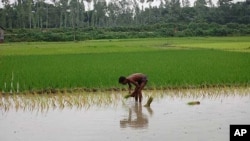In the run-up to the Copenhagen climate conference, many experts said agriculture should be a central issue in the discussions. After all, farmers are directly affected by climate change, they contribute up to a third of all man-made greenhouse gases, and they can also mitigate their impact by capturing excess carbon dioxide in the soil.
Many farmers worldwide hoped that negotiators in Copenhagen would devise a way to shield them from the heat waves, droughts, floods, and other unpredictable weather predicted under climate change, and reward them for activities that trap greenhouse gases. But agriculture wasn't mentioned in the final accord signed December 18th by the United States, China, India, Brazil, and South Africa.
"So it's basically back to the drawing board as far as agriculture is concerned," says Ajay Vashee, president of the International Federation of Agricultural Producers.
Vashee says at least negotiators agreed on a framework for a possible future agreement that could include farmers.
Farms vs. forests?
Experts note that agriculture is a newcomer to climate negotiations. By comparison, it took several years of talks before reducing emissions from deforestation received a pledge of financial backing in Copenhagen.
The details of that deal -- how countries can earn credit for preserving and restoring their forests -- are still sketchy, however. And the American Farm Bureau Federation, the nation's largest farmers' organization, warns that incentives to grow trees could backfire if they lead farmers to plant fewer crops.
"People need to understand that there [are] going to be some trade-offs here," says Russell Williams, the Farm Bureau's director of regulatory relations. "If you're taking this much land out of production, what's that going to do to food prices? They really need to find a way, if they're going to move forward with this stuff, to have these forestry and agriculture offsets harmonized so you don't have a perverse incentive to forest land that's going to feed people."
Farms + forests?
David Waskow, climate change program director at the advocacy group Oxfam America, says there are circumstances in which the pro-forest and pro-farming camps could be in opposition. "But I think there are also ways in which they can be very mutually beneficial." He says in some cases, introducing trees into cropping systems can improve yields while storing carbon.
"We've seen that in areas like the Sahel where farmers have increased tree cover, that's really been beneficial in terms of natural fertilizers, in terms of water retention," he says. "So there's actually quite a bit of synergy there."
Philosophical rift
Waskow says Oxfam is one of several organizations that prefer these kinds of ecologically-based solutions to the Western model of intensive agriculture using pesticides and chemical fertilizers.
There is a deep philosophical rift within the agriculture community on this issue. Those who say organic agriculture is the only way to go drew fire in Copenhagen from the Farm Bureau's Russell Williams.
"You just have to stand up and say, 'Hey, wait a second. It doesn't do anybody any good to denigrate Western agriculture,'" he says. "And no matter what you think, and no matter what you say, Western agriculture has become the most efficient land use for food. The United States feeds a whole heck of a lot of people."
And the world will have to feed a whole heck of a lot more people in the coming decades, experts say, even as a changing climate makes growing food more challenging. As climate change negotiations move forward, expect to see more sparks fly over the best way to reduce greenhouse gases while continuing to feed a hungry planet.




